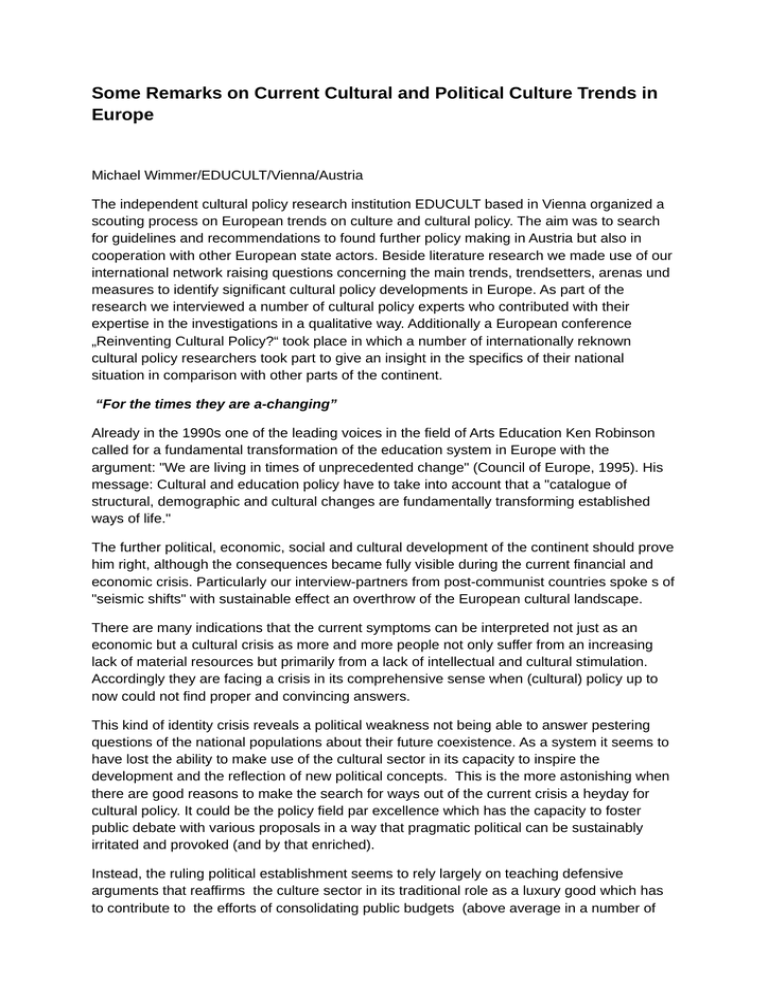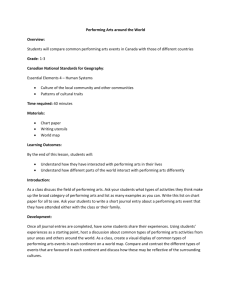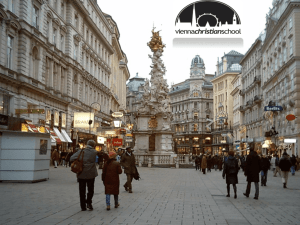Some Remarks on Current Cultural and Political Culture Trends in
advertisement

Some Remarks on Current Cultural and Political Culture Trends in Europe Michael Wimmer/EDUCULT/Vienna/Austria The independent cultural policy research institution EDUCULT based in Vienna organized a scouting process on European trends on culture and cultural policy. The aim was to search for guidelines and recommendations to found further policy making in Austria but also in cooperation with other European state actors. Beside literature research we made use of our international network raising questions concerning the main trends, trendsetters, arenas und measures to identify significant cultural policy developments in Europe. As part of the research we interviewed a number of cultural policy experts who contributed with their expertise in the investigations in a qualitative way. Additionally a European conference „Reinventing Cultural Policy?“ took place in which a number of internationally reknown cultural policy researchers took part to give an insight in the specifics of their national situation in comparison with other parts of the continent. “For the times they are a-changing” Already in the 1990s one of the leading voices in the field of Arts Education Ken Robinson called for a fundamental transformation of the education system in Europe with the argument: "We are living in times of unprecedented change" (Council of Europe, 1995). His message: Cultural and education policy have to take into account that a "catalogue of structural, demographic and cultural changes are fundamentally transforming established ways of life." The further political, economic, social and cultural development of the continent should prove him right, although the consequences became fully visible during the current financial and economic crisis. Particularly our interview-partners from post-communist countries spoke s of "seismic shifts" with sustainable effect an overthrow of the European cultural landscape. There are many indications that the current symptoms can be interpreted not just as an economic but a cultural crisis as more and more people not only suffer from an increasing lack of material resources but primarily from a lack of intellectual and cultural stimulation. Accordingly they are facing a crisis in its comprehensive sense when (cultural) policy up to now could not find proper and convincing answers. This kind of identity crisis reveals a political weakness not being able to answer pestering questions of the national populations about their future coexistence. As a system it seems to have lost the ability to make use of the cultural sector in its capacity to inspire the development and the reflection of new political concepts. This is the more astonishing when there are good reasons to make the search for ways out of the current crisis a heyday for cultural policy. It could be the policy field par excellence which has the capacity to foster public debate with various proposals in a way that pragmatic political can be sustainably irritated and provoked (and by that enriched). Instead, the ruling political establishment seems to rely largely on teaching defensive arguments that reaffirms the culture sector in its traditional role as a luxury good which has to contribute to the efforts of consolidating public budgets (above average in a number of countries like Italy or Spain). Against this retro trend there are just a few individual statements of national and European politicians in the form of normative claims to the artists ' Why art and culture can show us a way out of the crisis "(see Ulffe Elbaek/Culture Minister of Denmark and Androulla Vassiliou/Commisioner ofthe General Directorate for Education and Culture of the European Union; http://www.guardian.co .uk/commentisfree/2012/feb/25/europe-artists-chaos-hope). The Dwarfing of Europe? The prevalence of defensive postures is also confirmed by voices outside Europe challenging Europe as a global cultural centre with a long tradition. The European Cultural Foundation has recently kicked off a debate with intellectuals on the topic "The dwarfing of Europe?" which comes to the conclusion: "For centuries Europe itself considered to be the centre of the world. Many of the concepts and institutions that have shaped the Western world - in politics and economics, in philosophy, the arts and literature - have a strong European imprint .... Over the course the often bellicose 20th century, Europe lost its predominance for ever ". Most of our interview partners provided us with a picture of a continent that is forced on a global scale to reposition and to overcome traditional perceptions of its cultural supremacy. Other global actors, especially in Asia and Latin America are going to become much more aggressive (and successful) in promoting their cultural profiles than the old continent. To counteract this fragmentation there is an increasing desire for a new European narrative (Fe in the frame of the initiative “A Soul for Europe”) that could help to further develop a common cultural self-understanding and by that making Culture an integral part of a new design in the external relations with the world. Against this general impression of a shrinking significance we have to take into account that Europe, due to its comparably economic wealth combined with its constitutional and democratic traditions is still an important anchor of hope for millions of non-Europeans fleeing tyranny, oppression and poverty (and often fail at the borders of Fortress Europe). The current crisis also has made visible a deepening gap between a rich north and a poor south of Europe. These new divisions (after the overcoming of the division a capitalist West and a communist East) make all efforts increasingly cumbersome to maintain the appearance of something like a common European culture. Alarming concepts arguing for a new divide in Europe primarily along supposedly "incompatible" cultural barriers show the political explosive force of this kind of approaches (see the Italian philosopher Giorgio Agamben, with his concept of setting up "Latin Empire" against „German Dominance“ ) More Market, Less Politics Efforts from the civil society sector, such as the initiative "More Europe", flag counter trends in its aspirations to make use of culture as a "soft power" trying to redesign the external relationships in Europe as an expression of a common spirit. As such they have to be seen as rather viable also in the context of state cultural policies. Although European cultural politicians still make use of a political rhetoric from the 1970s defining "cultural policy as social policy" the majority of our interviewees speak of a general weakness of cultural policy: "cultural policy at the moment is flat, it cannot provide any perspectives" (Raj Isar). Instead of relying on specific achievements of the European welfare state model with cultural means (Austrian Chancellor Fred Sinowatz 1975: "Cultural policy is the continuation of social policy"), the main aspirations of cultural policy of today tend to foster further market orientation of the cultural sector. Even before the outbreak of the crisis, neoliberal tendencies have captured cultural policies on local, regional, national and of course also on European level. This led to the assumption that cultural policy has mutated increasingly to cultural industries policy and cultural management. This shift is due to an ideological trend which demands the gradual withdrawal of the state from the European societies (guaranteeing the maintenance of the European welfare state model). Accordingly the state should no longer constrain the market forces even in the fields of traditional state responsibility for public goods such as culture and education. The current status of market success can be observed in the periodic reissues to negotiate a global free trade agreement to stimulate the world economy (in accordance with these ideas particularly the United States took the position to include gradually also the cultural sector, whereas mainly representatives of a French "exception culturelle" try to maintain a counter position from a European perspective). In the absence of reasonable alternative political concepts most current cultural policy efforts in Europe follow a "more (or less) of the same" approach. This leads to a further transformation of the public cultural sector as a part of the "cultural industries". Accordingly also state cultural institutions are – although using public resources – forced to follow a market-based logic. This prevalence of an economistic perspective is connected with the hope to ensure favoured arguments for further public engagement and to make the cultural sector an important ingredient of future economic prosperity. Respective tensions can be read in the design of the new generation of the Culture Program of the European Union "A Creative Europe". Against this political hope production in favour of a further marketization of the cultural sector new conceptual efforts especially in England try to establish a new research area on "cultural values" (http://culturalvalueinitiative.org/) . After years of a dominant regime of New Labour fostering the "cultural industries" approach representatives of this research offensive hope to concert their results in a new quality of, not exclusively market oriented cultural policy decision making processes. During a European conference on „Reinventing Cultural Policy?“ in Vienna the dean of the Hertie School of Governance in Berlin, Helmut Anheier has raised the issue with the recommendation not to try to swim „against the market“: Also the cultural sector in Europe would have to accept to operate within a capitalist regime. In consequence, he sees a longterm weakening of public cultural policies on national level. Their significance would shift to the local political bodies, particularly when cities manage to integrate their cultural offer (as part of a "value chain") in a comprehensive branding to achieve competitive advantages. The prominent cultural policy analyst Raj Isar criticized this approach as a further step towards commercialization of the culture sector with the help of the public, who has lost all genuine cultural and political alternatives. Between Luxury and Precarity Neo-liberal tendencies, mentioned above led to a stricter divergence of the various social groups within European societies. The results can be found also in art and cultural production itself, especially in the field of fine arts, when the needs of an increasing number newly rich people (winners of the crisis) want to find its representation in the creations of the global art market. Based on the expectation of these new buyers a significant trend of a market-driven art and cultural production can be observed, which is directed to decorate a new wealth and legitimize, even more, on a global level to serve as evidence of apparent liberality of authoritarian regimes. The other side of the coin shows an increasing casualization of artists and creators who refuse to accept the market as the sole criterion of quality and consequently they are less and less able to live by the production of their artistic work (above). This kind of usage endangers a historically grown interpretation of artistic autonomy for which artists and intellectuals particularly in the post-communist countries had to fight for a long time. Additionally we are confronted with different interpretations of the term, Fe when a liberal practices in England the longest time were able to combine claims of artistic autonomy with (cultural) policy demands (in the frame of funding) to achieve external goals such as social integration or intercultural dialogue while in Central Europe large parts of the cultural sector would (yet) dismiss these specifications as incompatible with genuine artistic quality. Europe and its (cultural) diversity In his contribution "Culture, Creativity and the Young" Ken Robinson in 1995 could start with an encouraging observation: "Within Europe, there is an enormous diversity of cultural values and practices, within as well as between its member countries". The task of cultural policy would then be to make this diversity a driving factor for further social development of the continent. Meanwhile, we can observe the negative implications of a growing “heterogenisation” of European societies (and with it the political incapability to make use of it). They are water on the mills of right-wing forces which do not hesitate to exploit this kind of social drifting politically. Directed against further deepening of the European integration it meanwhile endangers the European project as a whole (and make concepts clear that art and culture both can support centripetal as well as centrifugal forces). In this context, there is a considerable systemic weakness of traditional departmental responsibilities particularly of the public administration systems, which Fe makes cooperation between cultural and integration policy difficult or impossible. Social differentiation Even more serious is the fact that the lives of the members of European populations and thus their cultural preferences have differentiated massively during recent years, drifting more and more apart from one another (see various life style studies like Sinus-MilieuStudies). Most of our interview partners assume that the public culture sector has lost considerably its power of social integration. Current efforts in the direction of renationalization, like in Hungary or Romania as a charade repetition of 19th century approaches, cannot change the general assumption. Here too, the lasting effects of an increasing marketization, can be observed. They have led to a welcomed levelling of primarily ideological barriers hindering many citizens accessing to segments of the public cultural sector (which were previously mainly subject to an educated middle-class elite and the needs of their representatives). The result is a more equal access to the cultural markets regardless the belonging to a social class. Thus, culture industry has realised a number of cultural policy targets, a "New Public Cultural Policy" has promised in the intention of a democratization of culture since the 1970s. This does not change the fact that - according to the German youth culture barometer - over the years no significant change in the user attitudes, especially in the area of privileged public art institutions can be detected. As if nothing would have happened respective offer are still primarily perceived by representatives of high and highest educated groups. The big rest of the population mainly refers to a commercial offering, whose scope and attractiveness has risen significantly in recent years. For a long time public cultural institutions believed that they could rely on fixed und regular audiences. Now they have to take into account permanent cultural changes especially in urban areas with a highly competitive range of (not only) cultural offers to meet the claims of more and more differentiated target groups. In this context, recent results of the German elite researcher Michael Hartmann should raise our awareness. As a result of his research he states a significant decline of cultural awareness among economic elites. His concern goes in the direction that during the last years an important promoter of public culture might have gone lost. It has so far contributed substantially to the cultural legitimacy of government action. This tendency is reinforced by a growing uncertainty of the middle-class population in Europe, who feel threatened by the current crisis phenomena in their social standing. As a result of the crisis they are losing their hopes that the occupation with art and culture might contribute to a sustainable improvement of their social standing. When public cultural policy in the 1970s was able to formulate convincingly its major task to provide "culture for all" we can see today a split-up of cultural and political actions in a dizzying variety of different, temporary scenes practicing their different interests. This makes it difficult to define cultural policies along common denominators. This trend is exacerbated by the fact that the mentioned differentiation into various cultural scenes, each represented with their "own culture", tend to lead to new exclusion mechanisms, contradicting hopes of extensive common participation with the implementation of new barriers. Following the concepts of cultural markets we are confronted with a new kind of "cultural pluralism", which can be characterized by a coexistence of different cultural scenes, unless they are able to compete in a "market of attention" at least temporarily. No doubt the new variety poses a special challenge to public cultural policy to go on with a unilateral prioritization of selected cultural institutions. From Audiences to Users This trend is exacerbated by the creation of new cultural spaces that have arisen with the massive innovation of the digital media. Due to an internationally acting "economicaltechnological complex" these new cultural spaces prove to be a crucial frame of reference for the cultural consciousness particularly of the young European (and not only European) generation. In principle placeless and “without nationality” these new cultural spaces offer previously unimaginable possibilities of interaction. Much of the appeals are based on the extensive availability of cultural goods (in digital form), but also on the active participation of the users, influencing their cultural awareness more than being part of a silent audience in the dark of a traditional cultural institution. Austria (still) appears as an exception that does not or if so, only very peripherally appears to be affected by most of the problems indicated here in this first tour d'horizon. Relatively stable public art and cultural budgets, new construction of cultural facilities, high occupancy rates at major cultural institutions suggest a continuity, which is also supported by a (so far) only relatively small impact of the European financial and economic crisis. But the longerterm trends that are increasingly visible in Europe, will - à la longue - have a considerable impact on the cultural-political internal climate as well in Austria as in all other European countries. The scouting process should give food for further considerations helping to raise awareness of this development and to give at least indirectly suggestions for further reflections and procedures. After this general overview the research includes main challenges, a discussion on the main actors, arenas and procedures and ends with a list of recommendations. You may find further details at: http://www.educult.at/en/forschung/kulturelle-und-kulturpolitische-trends-in-europa/





